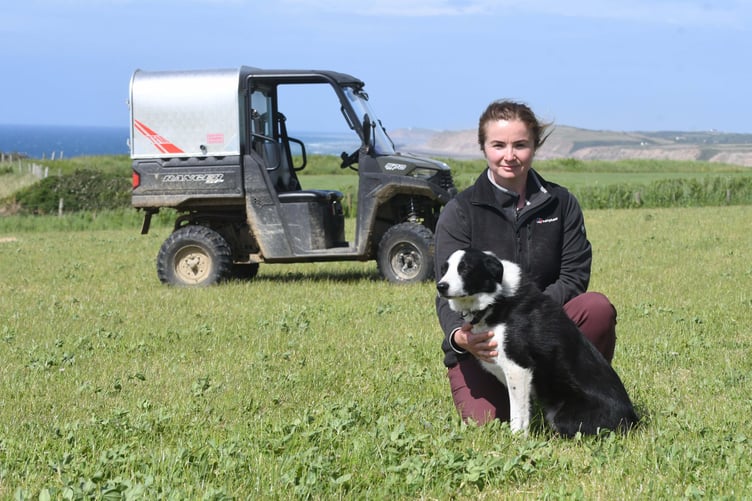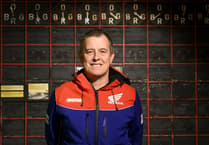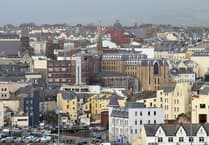When I was growing up I always said I wanted nothing to do with farming,’ says Chrissy Cannell.
Now she finds herself running the family farm at Ballacarnane, which is perched on the hills above the coast road just south of Kirk Michael. Their land stretches from the sea, over the old railway line, to the valley below Cronk Y Voddy.
I’m admiring their view from a small field beside the farmhouse. It’s an unusual piece of land, a small flat area on the hillside with springy turf indicating it hasn’t been cultivated. It’s a perfect sunny day but this piece of land has a rich history that has seen much darker times.
Chrissy and her father John are telling me about it.
John says: ‘This is an old burial ground. Five hundred years ago our ancestors, four brothers and a sister, took the gravestones off. The sister didn’t want to… and all the brothers were dead within a year.’
The farm carried on when the surviving sister married a Cannell from a nearby farm but no one has disturbed the burial ground since.
Reflecting the mix of cultures and religions the island has seen over the years, at one end of the field is a raised circle of earth which covers the remains of a keeill, where Christian worship would have taken place.
John says: ‘My grandfather cleaned it all out and he found the usual cobbles for the floor except at one end the cobbles were white, where the altar used to be.’
There is also an old chapel on their land, just up the lane from the farmhouse. It is no longer used for worship but last month Chrissy cleaned the place out and it became the ideal venue for an ADAS Knowledge Exchange event. The Knowledge Exchange Programme is run by ADAS (the UK’s largest independent provider of agricultural and environmental consultancy, policy advice and research and development) for DEFA in the island, as part of their support for Manx agriculture. Around 50 farmers from all around the island attended the event which featured UK soil expert Paul Newell Price talking about soil health and nutrition.
Chrissy says: ‘We went out to one of our fields and looked at different soil structures. What you can tell from what soil looks like can influence the decisions you make about how you work that field, what crops you’re going to put in it and what fertilisers you’re going to put on it.’
Another element of the Knowledge Exchange Programme has been the selection of young farmers as Development Farmers. Chrissy is one of these, along with Daniel Creer and Alice Foster, who farm at Ballaquinnea Beg.
Chrissy says: ‘They said they want two development farmers for the first year for a four year programme and in the second year they’ll get two more on board.
‘I was thinking that, as Dad has handed over the reins to me and I’m trying to figure out how to make the farm more sustainable, more profitable and more efficient, whilst facing all the challenges that are around today, some objective advice and suggestions would be really worthwhile.
‘I think they were keen to find people that are willing to learn and eager to embrace change and innovation, to keep trying to do better. There’s lots of challenges going to come up within the next few years and it’s all about how we adapt and tackle these challenges.’
‘As part of the scheme Dan and I both got our farm’s soil tested and were then given a suggested fertiliser and lime application plan. I think Dan and I have taken it on board and we’ve adapted it as best we can, bearing in mind recent fertiliser prices.’
And she adds: ‘When Dad was my age farming was in a very different place.’
John was just 19 when he took over Ballacarnane from his father, more than 60 years ago. He and his wife, Marilyn, had four daughters, of which Chrissy is the youngest.
Her circuitous route into farming saw her do two degrees, with some time spent travelling in between. Her second degree was in Post War Recovery Studies which, she explains, ‘is a mixture of peace, conflict and development studies, as I wanted to go off working in war zones and after natural disasters’.
Whilst applying for jobs in that industry, she found herself back on the island, working in a bank. John was now semi retired, had sold off most of the stock and rented out the land.
‘There were just 10 sheep left and the whole place was tenanted out,’ recalls Chrissy.
She goes on: ‘I started work at The Children’s Centre when they were starting to think about the community farm, so they got to know me and my background and I got involved with that from early doors. I was involved with that for five years, ending up managing the team.’
Then came a lightbulb moment. She says: ‘It was while I was there I suddenly thought: “I’ve got a farm at home, what am I doing?”’
John adds: ‘She came to me and said: “I want you to teach me everything you know”, so I had to start thinking about farming again.’
Gradually, over the next few years, Chrissy reduced her hours at work, as they took acreage back on and increased stock numbers. Now there are 300 breeding ewes on the farm and 20 breeding cattle and Chrissy is running the farm. Last year, she also joined the Fire Service, based at Kirk Michael.
‘Quite a few of the Kirk Michael firefighters are farmers or agriculturally connected,’ she says.
This came in very useful when, in early April just as they had started lambing at Ballacarnane, Chrissy was rushed into hospital to have her appendix out. It was then that she discovered just how supportive the local farming community, and her firefighter colleagues, are.
‘I ended up with a team of friends and neighbours helping, dividing up all the heavy lifting jobs as I could only just about open a gate, let alone catch a sheep!
‘It just goes to show how important the agricultural community is and how people will step in and help. Even though most of them were in the midst of lambing and calving themselves, they still found time to come and help.’




-(1).jpeg?width=209&height=140&crop=209:145,smart&quality=75)
Comments
This article has no comments yet. Be the first to leave a comment.